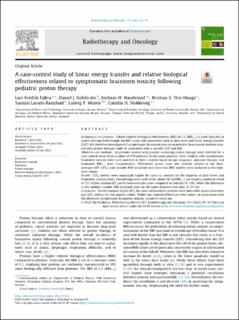| dc.contributor.author | Fjæra, Lars Fredrik | |
| dc.contributor.author | Indelicato, Daniel J. | |
| dc.contributor.author | Handeland, Andreas Havsgård | |
| dc.contributor.author | Ytre-Hauge, Kristian Smeland | |
| dc.contributor.author | Lassen-Ramshad, Yasmin | |
| dc.contributor.author | Muren, Ludvig Paul | |
| dc.contributor.author | Stokkevåg, Camilla Hanquist | |
| dc.date.accessioned | 2022-09-30T12:16:16Z | |
| dc.date.available | 2022-09-30T12:16:16Z | |
| dc.date.created | 2022-09-15T13:42:32Z | |
| dc.date.issued | 2022 | |
| dc.identifier.issn | 0167-8140 | |
| dc.identifier.uri | https://hdl.handle.net/11250/3022921 | |
| dc.description.abstract | Background and purpose
A fixed relative biological effectiveness (RBE) of 1.1 (RBE1.1) is used clinically in proton therapy even though the RBE varies with properties such as dose level and linear energy transfer (LET). We therefore investigated if symptomatic brainstem toxicity in pediatric brain tumor patients treated with proton therapy could be associated with a variable LET and RBE.
Materials and methods
36 patients treated with passive scattering proton therapy were selected for a case-control study from a cohort of 954 pediatric brain tumor patients. Nine children with symptomatic brainstem toxicity were each matched to three controls based on age, diagnosis, adjuvant therapy, and brainstem RBE1.1 dose characteristics. Differences across cases and controls related to the dose-averaged LET (LETd) and variable RBE-weighted dose from two RBE models were analyzed in the high-dose region.
Results
LETd metrics were marginally higher for cases vs. controls for the majority of dose levels and brainstem substructures. Considering areas with doses above 54 Gy(RBE1.1), we found a moderate trend of 13% higher median LETd in the brainstem for cases compared to controls (P =.08), while the difference in the median variable RBE-weighted dose for the same structure was only 2% (P =.6).
Conclusion
Trends towards higher LETd for cases compared to controls were noticeable across structures and LETd metrics for this patient cohort. While case-control differences were minor, an association with the observed symptomatic brainstem toxicity cannot be ruled out. | en_US |
| dc.language.iso | eng | en_US |
| dc.publisher | Elsevier | en_US |
| dc.rights | Navngivelse 4.0 Internasjonal | * |
| dc.rights.uri | http://creativecommons.org/licenses/by/4.0/deed.no | * |
| dc.title | A case-control study of linear energy transfer and relative biological effectiveness related to symptomatic brainstem toxicity following pediatric proton therapy | en_US |
| dc.type | Journal article | en_US |
| dc.type | Peer reviewed | en_US |
| dc.description.version | publishedVersion | en_US |
| dc.rights.holder | Copyright 2022 The Author(s) | en_US |
| cristin.ispublished | true | |
| cristin.fulltext | original | |
| cristin.qualitycode | 1 | |
| dc.identifier.doi | 10.1016/j.radonc.2022.07.022 | |
| dc.identifier.cristin | 2052063 | |
| dc.source.journal | Radiotherapy and Oncology | en_US |
| dc.source.pagenumber | 47-55 | en_US |
| dc.identifier.citation | Radiotherapy and Oncology. 2022, 175, 47-55. | en_US |
| dc.source.volume | 175 | en_US |

